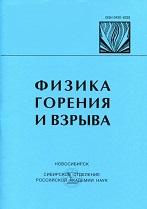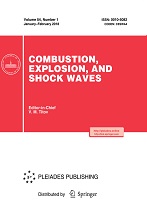|
This article is cited in 2 scientific papers (total in 2 papers)
Turbulent deflagrations, autoignitions, and detonations
D. Bradleya, M. Lawesa, M. Mansourb
a School of Mechanical Engineering, University of Leeds, LS2 9JT, Leeds, UK
b King Abdullah University of Science and Technology, Thuwal, Saudi Arabia
Abstract:
Measurements of turbulent burning velocities in fan-stirred explosion bombs show an initial linear increase with the fan speed and RMS turbulent velocity. The line then bends over to form a plateau of high values around the maximum attainable burning velocity. A further increase in fan speed leads to the eventual complete quenching of the flame due to increasing localised extinctions because of the flame stretch rate. The greater the Markstein number, the more readily does flame quenching occur. Flame propagation along a duct closed at one end, with and without baffles to increase the turbulence, is subjected to a one-dimensional analysis. The flame, initiated at the closed end of the long duct, accelerates by the turbulent feedback mechanism, creating a shock wave ahead of it, until the maximum turbulent burning velocity for the mixture is attained. With the confining walls, the mixture is compressed between the flame and the shock plane up to the point where it might autoignite. This can be followed by a deflagration to detonation transition. The maximum shock intensity occurs with the maximum attainable turbulent burning velocity, and this defines the limit for autoignition of the mixture. For more reactive mixtures, autoignition can occur at turbulent burning velocities that are less than the maximum attainable one. Autoignition can be followed by quasi-detonation or fully developed detonation. The stability of ensuing detonations is discussed, along with the conditions that may lead to their extinction.
Keywords:
turbulent deflagrations, autoignitions, detonations, flame quenching.
Received: 14.10.2011
Citation:
D. Bradley, M. Lawes, M. Mansour, “Turbulent deflagrations, autoignitions, and detonations”, Fizika Goreniya i Vzryva, 48:5 (2012), 39–49; Combustion, Explosion and Shock Waves, 48:5 (2012), 526–535
Linking options:
https://www.mathnet.ru/eng/fgv1035 https://www.mathnet.ru/eng/fgv/v48/i5/p39
|


| Statistics & downloads: |
| Abstract page: | 34 |
|





 Contact us:
Contact us: Terms of Use
Terms of Use
 Registration to the website
Registration to the website Logotypes
Logotypes








 Citation in format
Citation in format 
